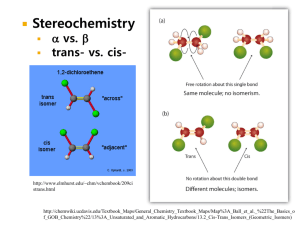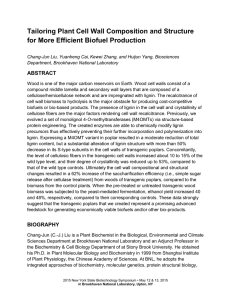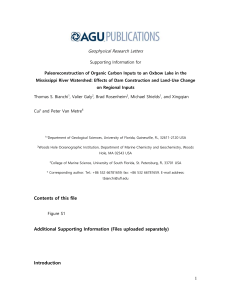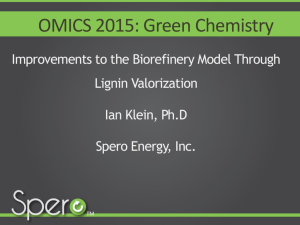11 J THE REACTION Cl' METHYL HYPOCHEORITE WITH I.IGNI N Madison, Wisconsi n
advertisement
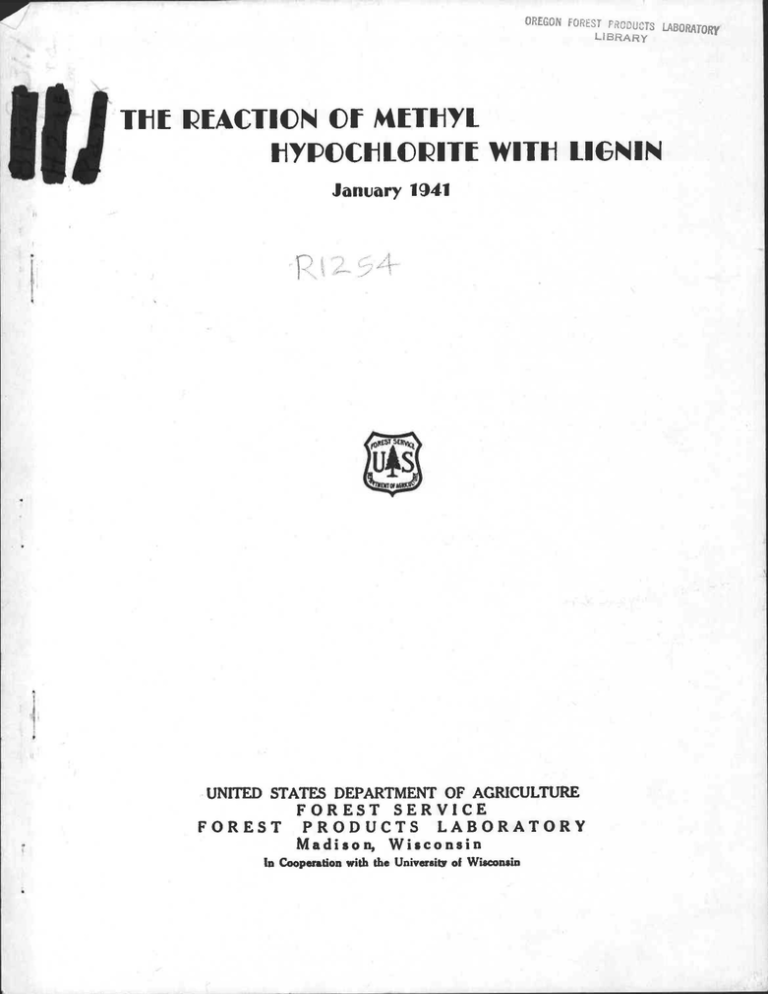
11 J
OREGON FOREST PRODUCTS LABO
RATORY
LIBRAR Y
THE REACTION Cl' METHY L
HYPOCHEORITE WITH I.IGNI N
January 194 1
UNITED STATES DEPARTMENT OF AGRICULTUR E
FOREST SERVIC E
FOREST PRODUCTS LABORATOR Y
Madison, Wisconsi n
In Cooperation with the University of Wisconsin
(THAI REACTION OF METHYL HYPOCHLORITEWITH LIGNIN'
By ELWIN P .
RIS, Chemis t
and LYLE t . tQFDAHL, Student Assistan t
R
Lignin reacts with chlorine . in methanol solution to give a
product containing a higher methoxyl content than would be expecte d
If the methanol did not enter the reaction . Since som e , methyl hyp o
chlorite will be formed by the action of chlorine on methanol, it wa s
.thought that methyl hypochlorite, which is known to add to ethyleni c
linkages (l, 2), had added to ethylenic linkages in lignin, If thi s
reaction were quantitative, it might be used t0 determine the numbe r
of ethylenic linkages in lignin .
This paper covers a study of the reaction of lignin with methy l
hTpochlorite prepared by different methods .
Experimenta l
Chlorination of lignin inmethanol .--Five grams of dried ligni n
was suspended it dried methanol, the mixture was cooled to and .main tained- at 10° ; dried chlorine was introduced until no further chang e
in the color of the resulting product was evident . During the reactio n
lignin ; which was not previously dissolved, went into solution . The
mixture was poured on crushed ice and washed with ice water until th e
wash water gave no test with starch-iodide paper . The product wa s
driedin a vacuum at room temperature . Table 1 shows the compositio n
of various lignins which have been treated with chlorine in methanol ;
yield approximately 6 .5 g .
4,
Chlorination of lignin in methanol in the presence of bariu m
carbonate .--Five grams of dried lignin was mixed with 200 cc . of drie d
methanol and 25 g, of anhydrous barium carbonate added ., While stirring
and cooling the mixture to 10°, dried chlorine was introduced until n o
further change bras evident . The mixture was filtered to remove th e
excess barium carbonate and then poured on crushed ice, which precipitated the lignin derivative as a light yellow powder .-- This powder was
then recovered o n , & Bil.chner filter and washed with ice water until fre e
from chlorine . The product was first air dried on the filter and the n
dried in vacuum . The yield of chlorinated material was approximatel y
5 .g g .
-Published in Journal of the American Chemical Society 63(1) :112 (1 9141) .
Presented before the American Chemical Society, Detroit, Mich . ,
Sept . 9-13, 1940 .
81.2514
- Table_2 gives'the methoxyl and chlorine content of the lignin s
treated .
Lignin treated with dichlorourea and methanol .--Three grams o f
the most soluble fraction of maple' methanol lignin (3), a=hich containe d
27 percent methoxyl, was dissolved in 200 cc . of methanol which had '
been dried over drierite and distilled . To this solution dried dias
chlorourea, prepared according to the method of Chattaway (4),
.
Th e
added in varying amounts and allowed 'to stand for about 1 hour
.
The
preci
p isolution was poured on - 400 ' g . of crushed ice and agitated
tate was washed with ice water until the wash water showed no 'react io n
for chlorine . The'product was dried for a short tithe by drawing ai r
through it on'a Buchner funnel and then dried - in vacuum . Table 3 con-.
tains the•methaxyl and chlorine contents of methanol lignin treate d
with varying amounts of dichlorourea at different temperatures . The
yield of chloro compounds ranged from 3 .3 to 3 . g g .'depending'on the
temperature and .the chlorourea used .
The action of Methyl hypochlorite on lignin .--A solution o f
methyl hypochlorite in carbon tetrachloride was prepared according to
the method of Taylor ; McMullen and Gammal (5) . Two hundred cubic centimeters'of this solution containing approximately 5 g . of methyl hypochlorite .was az .ded .to a mixture containing 5 g .•of lignin in 200 cc .
of . methanol while stirring and cooling . The stirring was continue d
for an hour after the methyl hypochlorite solution had been added .
The solvent-was evaporated at - room temperature by distillation . i n
vacuum, using a water pump, until about 50 cc. remained . The concentrated solution was added to l .ltter of „ petroleum ether (b .p . g 0-100 0 ) ,
which precipitated the lignin derivative as a flocculent powder . The
powder was filtered from the'solution and washed with petroleum ethe r
until the filtrate gave no-reaction for chlorine .' The yield of chloro- .
lignin ranged from 5 .5 to 6.5 g . 'Tabl e , 4 gives the methoxyl and chlorin e
content of the lignins treated .
Results and Discussio n
. From table 1 it may be noted that the reaction of chlorine wit h
lignin in methanol gave a product containing more methoxyl than th e
original lignin . Isolated lignin was used for this study so that any
increase in methoxyl was due to reaction during the chlorination an d
not previous to the chlorination, as stated by Jansen and Bain (6) ,
who also observed an"increase in'the methoxyl content of lignin obtained by the chlorination of wood in methanol . The amount of chlorine
taken up by isolated spruce lignin when chlorinated .in methanol wa s
approximately the same as that found by Jansen and Bain, who chlorinate d
spruce wood and extracted the lignin derivative . Their product contained 15,9 percent methoxyl and 35.6 percent chlorine, as compare d
R1254
with 16. g percent methoxyl and 34 .1 percent chlorine in this report .
Isolated lignin took up a slightly greater amount of methoxyl than
combined lignin . The greater absorption of methoxyl with isolate d
lignin may be due to conditions being more favorable for the reaction .
It is apparent that a part of the chlorine adds to lignin as methy l
hypochlorite . In table 1, using approximately 950 which has bee n
referred to previously (7) as a unit weight for lignin to betreated ,
it is shown that maple lignin (with a methoxyl content of 20 .6 percent) ,
methanol maple lignin (with a methoxyl content of 27 percent), an d
methanol spruce lignin (with a methoxyl content of 20 .4 percent) hav e
taken on, during the chlorination, two methoxyl groups each while spruc e
lignin (with a methoxyl content of 17 percent) has taken up three .- Thi s .
would account for the presence of two ethylenic linkages in the sample s
of maple lignin and three such-linkages in spruce lignin having a methoxy l
content of 17 percent, if methyl hypochlorite is added to these bonds ..
Chlorine other than that in the methyl hyooclalorite reacted with th e
lignin, giving a product with a high chlorine content .
Referring to table 2, if barium cerbgnate is added to . the chlorinatingmixture, thee' chloride ion would be removed and substitutio n
reactions would be largely eliminated because most of the chlorin e
would be present as the hypochlorite . In methanol solution this Would '
be present as methyl hypochlorite . Table 2 gives the'comiposition .o f
lignin chlorinated at 10° in the presence of barium carbonate . In thi s
reaction less'chlorine was found in the lignin derivatives, than that '
shown in table 1, but the amount was-still in .excess of the amount tha t
would be present if the entire reaction were due to the addition o f
methyl hypochlorite . The increase in . . methoxy'centerit'^ras the same a s
that shown in table I . In this table it is shown that fullymethyla .ted •
maple lignin adds two methoxyls and therefore "itt•'is apparent tha t
nethylation does not change the degree of unsaturation of the ligni n
molecule .
When working with phenylethylene, Alpatov (8) found that dichlorourea in methanol produced methyl hypochlorite which added to th e
double bond of phenylethylene to produce a-phenyl, a-methoxy, and . R chloroethylene . This method of determining the presence of double bond s
was applied tp the most soluble fraction of methanol maple lignin containing 27 percent methoxyl . Table 3 shows the composition of methy l
hypochlorite addition compounds produced by treating this lignin wit h
dichlorourea in methanol . However, in each case chlorine in excess o f
that in the methyl hypcchlorite also reacted with the lignin . Temperature ranges from 5° to 20° had very little. effect on the reaction . A t
30° the reaction proceeded as if free chlorine were added to' the methano l
solution of lignin . The same amount of methoxyl was added if 3, 7 o r
15 g . of dichlorourea were added but the amount of chlorine introduce d
increased with the increase in nuantities of dichlorourea . The methoxy l
groups in the lignin unit of 950 weight increased from 8 to 10, shorin g
evidence of two ethylenic groups .
Rc1254
-3-
s' i
..)DJ•CT LABORATOR Y
'ST
LIBRARY
Table 4 contains the composition of lignin samples treated wit h
a carbon tetrachloride solution of methyl hypochlorite . At 1 0 0 result s
similar to those obtained with dichlorourea were obtained . The product s
obtained at 25° indicated that the methyl hypochlorite must have decom posed and then reacted as free chlorine . Conclusion s
Lignin reacts with chlorine in methanol to produce compounds con taining more methoxyl than the starting material .
Methyl hypochlorite prepared in various ways reacts with mapl e
lignins to produce compounds containing two methoxyl groups in excess o f
those of the starting material and with various spruce lignin samples t o
produce compounds with two or three methoxyl groups in excess of .th e
starting material .
The addition of these methoxyl groups indicates the presence o f
two ethylenic groups in maple lignin and two or three, depending on th e
derivative, in spruce lignin .
Literature Cite d
1. P. D . Bartlett and D . S . Tarbell .
( 1936) .
our . Amer . Chem . Soc . 58 :466
2. E. L . Jackson. Jour . Amer . Chem . Soc . 56 :977 (1934) .
3.
E. E . Harris . Report presented before the American Chemica l
Society, Pittsburgh, Pa ., 1936, unpublished .
4. F. 0 . Chattaway . Chem . News 98 :285
(1909) .
5. M . C . Taylor, R . B . McMullen and C . A . Gammal . Jour . .Amer . Chem .
Soc . 47 :395 ( 1 925) .
6. G. V . Jansen and J . W . Bain . Can . J . Research
15 :279 (1937) .
7.
E. E . Harris . Jour . Amer . Chem . Soc . 58 :894 (1936) .
8.
D . M . Alpatov . Acta Univ . Voronegiensis 3 :172 ( 1937) .
81254
a)
ai
0
o
0
•rt
.
0
o 0
O0
4-5
Iti a)
R, ni a17 :
1 :.1
rr-I
r -I
1
O
'CO
150
4-1
'A' $4
•0 10 00
.0
•0 00
d
•
M
U
r1
t
a)
I
-
..
..
p
I
II I
a) a)
t. H
O 4-1 I
4-t al
a) a) I
XI
a)
0
H
81254
i
4
1
am
t
t
..
+'
1
~r
..
.. ..
r-1
O
-P
a)
a)
W
I
I
..
lD
•
¼.D
r1
.0 •0 •6 •6 00
0
CJ
M
r-1
•
M
. 0
b0
M
M
130
•
‘-D
r-1
r-1
lD O 0
.0-
M
•
ri
N
IrI
•
S
i
a)
U
a)
N N
r-i
N
a)
ri
0
~P
{
0
!A _1
¢i U
c
0
F-4 )
bD
I
LC]
kC]
‘'d
rr
LC]
I
to
N•
Ol
•
tO
•
r^!
r1
r-i
N• 6O•
CJ
N
1
r
1
6
O
0
a)
C)
Fi
a)
P-1
66 60 •6
4
R125 F
6 66 64
LC]
d
r1
•
N
•w
•6 46 • 6
N
N
to
or,
G eO
■
•
01
r-I CT
r-i
ILl
• I-^•
Crl
N
r-l
0 0 0
a)
N-
rO
O
c?
0
0)
-
LU
p o
1-
Trl N
0•
0,1
r-
r-I
t
0
N
S,
Table 3 .--Methanol maple lignin treated with dichloroure a
in methanol solutio n
Befor e
treatment :
:
:
t.i
After treatment
Temperature ; Amount
of urea
: Approximat e
•
: used
: Methoxyl Methoxyl : Chlorine : ratio o f
:
group s
MeO/C
l
▪
° C.
Grams
:
3
7,
:
Percent
5
5
5
15
10
10
10
3
7
15
:
:
27
27
27
3
7
15
:
:
:
27
27
27
20
20
3
7
•
:
27
27
30
7
15
15
15
•f
:
•
•
:
:
27
27
27
27
Percent :
▪
:
:
:
Percent :
26. g
26.7
25 . 14
:
:
:
11 .9
1 1+.43
:
17 .9
:
:
10/ 1 4
10/ 5
10/ 6
27 . g
26 .5
26 .2
:
:
:
13 .15
14. g
:
:
10/ 4
16 .2
:
10/ 6
27 .6
26 .5
25 .3
:
:
:
1 .3 g
14 . g
:
17 .2
:
1o/ 4+
10/ 5
10/ 6
25 . g
27 .1
:
:
13 .1
:
15 .0
:
10/ 14
23 .0
:
30 .0
:
10/ 5
10/ 5
1o/1 1 4
.
!f
:S .
R1251 4
A1:
a)
)
4- i
O
H
0
▪
q •r1
F i
IX1 r t
Pr
o
k
LO
O
1
a)
0
to
m
to
0■
Ol
tO
O • r-1
N
04
r-t
. m
to
Pi k
M
H
0
4-1
0
ri
tO
C)1
1~M
LC•1 0▪
ti M•
M•
N N r-I N r•i
CD
U
a)
Pa
P-
0
N
.,
,
4
O
N
O '•
'.0
OO
N
O
N
Q
•
••
•
ri
▪
•
•
H
▪
•
a)
U
•
v)
W
H
S
••
1
0
4-i
q
Q
4-1
)
4
-ri
•
I
I
I
1
•ri
1-4
:
•
▪
•
a)
v
C`
~]
•r4
P.N
v
a
rii
v
-P
r-l
Pi
ri
Pi
i
0)
rIEL
I
~
A A
R1254
.•
rl
•rr
rI
m
'A' co
•
•
t
•r
•r i
r-I
a)


